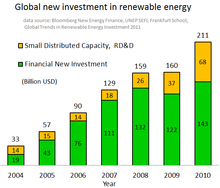|
Energy crisis
An energy crisis or energy shortage is any significant bottleneck in the supply of energy resources to an economy. In literature, it often refers to one of the energy sources used at a certain time and place, in particular, those that supply national electricity grids or those used as fuel in industrial development. Population growth has led to a surge in the global demand for energy in recent years. In the 2000s, this new demand – together with Middle East tension, the falling value of the US dollar, dwindling oil reserves, concerns over peak oil, and oil price speculation – triggered the 2000s energy crisis, which saw the price of oil reach an all-time high of $147.30 per barrel ($926/m3) in 2008.[citation needed] Most energy crises have been caused by localized shortages, wars and market manipulation. However, the recent historical energy crises listed below were not caused by such factors. Causes Most energy crises have been caused by localized shortages, wars and market manipulation. Some have argued that government actions like tax hikes, nationalisation of energy companies, and regulation of the energy sector shift supply and demand of energy away from its economic equilibrium.[1] However, the recent historical energy crises listed below were not caused by such factors. Market failure is possible when monopoly manipulation of markets occurs. A crisis can develop due to industrial actions like union organized strikes or government embargoes. The cause may be over-consumption, aging infrastructure, choke point disruption, or bottlenecks at oil refineries or port facilities that restrict fuel supply. An emergency may emerge during very cold winters due to increased consumption of energy. Large fluctuations and manipulations in future derivatives can impact price. Investment banks trade 80% of oil derivatives as of May 2012, compared to 30% a decade ago.[2] This consolidation of trade contributed to an improvement of global energy output from 117,687 TWh in 2000 to 143,851 TWh in 2008.[3] Limitations on free trade for derivatives could reverse this trend of growth in energy production. Kuwaiti Oil Minister Hani Hussein stated that "Under the supply and demand theory, oil prices today are not justified," in an interview with Upstream.[4] Pipeline failures and other accidents may cause minor interruptions to energy supplies. A crisis could possibly emerge after infrastructure damage from severe weather. Attacks by terrorists or militia on important infrastructure are a possible problem for energy consumers, with a successful strike on a Middle East facility potentially causing global shortages. Political events, for example, when governments change due to regime change, monarchy collapse, military occupation, and coup may disrupt oil and gas production and create shortages. Fuel shortage can also be due to the excess and useless use of the fuels. Historical crises
20th century
2000s

2010s
2020s National Balancing Point NBP (UK) natural gas prices Europe TTF natural gas prices United States Henry Hub natural gas prices
Emerging oil shortage"Peak oil" is the period when the maximum rate of global petroleum extraction is reached, after which the rate of production enters terminal decline. It relates to a long-term decline in the available supply of petroleum. This, combined with increasing demand, significantly increases the worldwide prices of petroleum-derived products. Most significant is the availability and price of liquid fuel for transportation. The US Department of Energy in the Hirsch report indicates that "The problems associated with world oil production peaking will not be temporary, and past 'energy crisis' experience will provide relatively little guidance."[20] Mitigation effortsTo avoid the serious social and economic implications a global decline in oil production could entail, the 2005 Hirsch report emphasized the need to find alternatives, at least ten to twenty years before the peak, and to phase out the use of petroleum over that time. Such mitigation could include energy conservation, fuel substitution, and the use of unconventional oil. Because mitigation can reduce the use of traditional petroleum sources, it can also affect the timing of peak oil and the shape of the Hubbert curve. Energy policy may be reformed leading to greater energy intensity, for example in Iran with the 2007 Gas Rationing Plan in Iran, Canada and the National Energy Program and in the US with the Energy Independence and Security Act of 2007 also called the Clean Energy Act of 2007. Another mitigation measure is the setup of a cache of secure fuel reserves like the United States Strategic Petroleum Reserve, in case of national emergency. Chinese energy policy includes specific targets within their 5-year plans. Andrew McKillop has been a proponent of a contract and converge model or capping scheme, to mitigate both emissions of greenhouse gases and a peak oil crisis. The imposition of a carbon tax would have mitigating effects on an oil crisis.[citation needed] The Oil Depletion Protocol has been developed by Richard Heinberg to implement a powerdown during a peak oil crisis. While many sustainable development and energy policy organisations have advocated reforms to energy development from the 1970s, some cater to a specific crisis in energy supply including Energy-Quest and the International Association for Energy Economics. The Oil Depletion Analysis Centre and the Association for the Study of Peak Oil and Gas examine the timing and likely effects of peak oil. Ecologist William Rees believes that
Due to a lack of political viability on the issue, government-mandated fuel prices hikes are unlikely and the unresolved dilemma of fossil fuel dependence is becoming a wicked problem. A global soft energy path seems improbable, due to the rebound effect. Conclusions that the world is heading towards an unprecedented large and potentially devastating global energy crisis due to a decline in the availability of cheap oil lead to calls for a decreasing dependency on fossil fuel. Other ideas concentrate on design and development of improved, energy-efficient urban infrastructure in developing nations.[21] Government funding for alternative energy is more likely to increase during an energy crisis, so too are incentives for oil exploration. For example, funding for research into inertial confinement fusion technology increased during the 1970s. Kirk Sorensen and others[22] have suggested that additional nuclear power plants, particularly liquid fluoride thorium reactors have the energy density to mitigate global warming and replace the energy from peak oil, peak coal and peak gas. The reactors produce electricity and heat so much of the transportation infrastructure should move over to electric vehicles. However, the high process heat of the molten salt reactors could be used to make liquid fuels from any carbon source. Social and economic effectsThe macroeconomic implications of a supply shock-induced energy crisis are large, because energy is the resource used to exploit all other resources. Oil price shocks can affect the rest of the economy through delayed business investment,[23] sectoral shifts in the labor market,[24] or monetary policy responses.[25] When energy markets fail, an energy shortage develops. Electricity consumers may experience intentionally engineered rolling blackouts during periods of insufficient supply or unexpected power outages, regardless of the cause. Industrialized nations are dependent on oil, and efforts to restrict the supply of oil would have an adverse effect on the economies of oil producers. For the consumer, the price of natural gas, gasoline (petrol) and diesel for cars and other vehicles rises. An early response from stakeholders is the call for reports, investigations and commissions into the price of fuels. There are also movements towards the development of more sustainable urban infrastructure.   In the market, new technology and energy efficiency measures become desirable for consumers seeking to decrease transport costs.[27] Examples include:
Other responses include the development of unconventional oil sources such as synthetic fuel from places like the Athabasca Oil Sands, more renewable energy commercialization and use of alternative propulsion. There may be a relocation trend towards local foods and possibly microgeneration, solar thermal collectors and other green energy sources. Tourism trends and gas-guzzler ownership varies with fuel costs. Energy shortages can influence public opinion on subjects from nuclear power plants to electric blankets. Building construction techniques—improved insulation, reflective roofs, thermally efficient windows, etc.—change to reduce heating costs. The percentage of businesses indicating that energy prices represent a barrier to investment has increased in 2022 (82%) as found in recent surveys, particularly for those who see it as a significant obstacle (59%). According to varied energy prices and energy intensity across nations and industries, various countries have different percentages of businesses that view energy costs as a key obstacle, ranging from 24% in Finland to 81% in Greece for example.[28] Crisis managementAn electricity shortage is felt most acutely in heating, cooking, and water supply. Therefore, a sustained energy crisis may become a humanitarian crisis. If an energy shortage is prolonged a crisis management phase is enforced by authorities. Energy audits may be conducted to monitor usage. Various curfews with the intention of increasing energy conservation may be initiated to reduce consumption. For example, to conserve power during the Central Asia energy crisis, authorities in Tajikistan ordered bars and cafes to operate by candlelight."Crisis Looms as Bitter Cold, Blackouts Hit Tajikistan". NPR. Retrieved 10 February 2008. In the worst kind of energy crisis energy rationing and fuel rationing may be incurred. Panic buying may beset outlets as awareness of shortages spread. Facilities close down to save on heating oil; and factories cut production and lay off workers. The risk of stagflation increases.[citation needed] See also
References
Further reading
External linksWikimedia Commons has media related to Energy crises.
|
